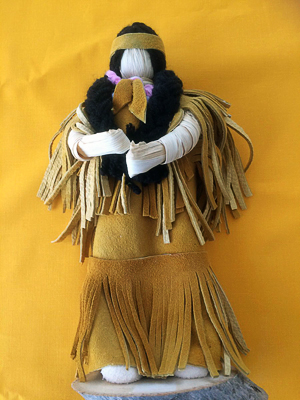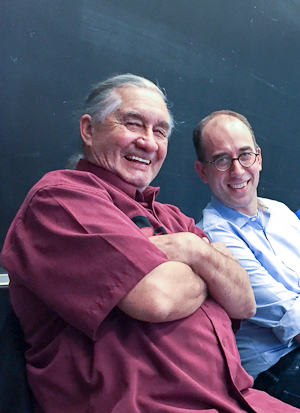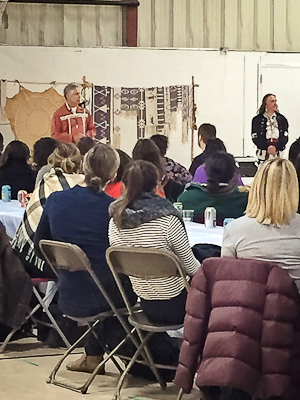
How can we learn about Indigenous legal traditions in a law school setting? What skills do lawyers practicing in Aboriginal law or working across cultures need to develop? What does reconciliation look like? The Kawaskimhon Aboriginal Law Moot, an annual non-competitive moot based on negotiation, first held at the University of Toronto in 1994 and hosted this March at McGill’s Faculty of Law, has some of the answers.
By Professor Kirsten Anker
|
|
|
|
|
|
Last June, a bulky red suitcase was delivered to my office at the Faculty of Law. It was the Kawaskimhon “bundle”, sent from the previous hosts of the Moot at the University of Calgary. I opened it and carefully unwrapped a carved talking stick, an eagle smudging feather, a leather pouch containing tobacco, cedar, sage and sweetgrass, a two-row wampum replica, a Métis belt, a button blanket, embroidered moccasins – all treasured items gifted by previous Moot hosts, and representative of significant ceremonies, medicines, protocols or symbols in different Indigenous traditions across Canada.
Passing the bundle each year is a charming tradition of the Moot, but it is also indicative of the way the organization of different aspects of the Moot draws students into alternative legal orders. In its sacred form, a bundle contains items that heal or teach their holders, that provide touchstones for their identity and that are used in ceremony; they are precious gifts. But even the Moot’s non-sacred bundle incorporates each host and Moot participant as a recipient of the gifts; I am keeping this bundle for a year, but it does not belong to me. During the Moot, the items are laid out and students are encouraged to take the time to pick them up and learn about them.
Taking the time, for holding significant objects, for ceremony, and for hearing from all participants is an important lesson from the Moot. While action-oriented lawyers tend to want to rush to results, they will soon learn that if good relationships have not been formed, if the parties do not feel they have been heard, then the resulting “agreement” will not be worth the paper it is written on. Like many other things, law can be as much about the process as the destination. And so the Kawaskimhon Moot, unlike standard adversarial moots, draws on Indigenous traditions of consensus building to deal with the Moot “problem,” which might be whether provincial smoking bans apply to businesses on reserve, how to structure an inquiry in Murdered and Missing Aboriginal Women, where or whether to draw boundaries in overlapping land claims, or who gets to represent a diverse Indigenous community in development consultations.
This year, the problem concerned the status of cultural property unearthed in lands around the Kanien’kehá:ka (Mohawk) community of Kanehsatà:ke near Oka, Quebec, and the broader colonial history of conflict over those lands. The problem itself was developed through negotiation, as the Moot organisers – myself and lawyer/alumna Lysane Cree – took guidance from elders and other members of Lysane’s community, as well as from our own Indigenous Moot alumni. Elders always play a significant role at the Moot: they are on hand to offer teachings to participants and may conduct ceremonies such as smudging or, in our case, the Ohen:ton Karihwatehkwen thanksgiving prayer that expresses gratitude to all the levels of creation.
These kinds of ceremonies can affect you even if you are not immersed in the culture from which they come. For instance, the smell of burning sweetgrass or sage used in smudging, and the gentle movements of a feather fanning the smoke can calm you. Conscientiously giving thanks is shown to improve mental health; what’s more, once you have elaborated the multitude of elements in the world of which you are a part, from stars to insects, your dispute with the other party is put in its cosmic place and may start to seem slightly less important! As I have been taught, “a good mind” (Ka’nikonhrí:io) is one of the three foundational pillars of the legal tradition that Kanien’kehá:ka inherit as the Great Law of Peace (Kaianere’kó:wa). These rituals are then not empty window dressing, but an important part of the legal processes drawn on in Moot negotiations.
Students arrive at the three-day Moot having prepared either a factum or a negotiation proposal on behalf of their party. This year, we had eight parties representing a variety of provincial, federal and Indigenous governments or bodies. But students are typically a little nervous about how the negotiations will unfold because there is little by way of pre-ordained structure. Each of our four tables were allocated a facilitator with expertise in Aboriginal or Indigenous law, who helped participants focus on relevant issues, develop a workable process, and identify pathways to resolution. At one table, for instance, the facilitator, a Kanien’kehá:ka professor at Carlton University, divided teams into the three clans that would be represented in a traditional Kanien’kehá:ka longhouse.
Each “clan” has a distinct role – one presents an issue, which is then discussed openly by the other two clans – but because each clan allocated at the table was made up of a combination of the different parties, the process of preparing for open discussion had already provided a chance for some preliminary consensus-building that facilitated the wider negotiations. While students I spoke to were initially taken aback by the mixing of parties who are usually adversaries, they remarked on how helpful it was in the end to really listen to each other and engage in a less formal setting, to combine and recombine the groups. Other tables used a talking circle to enable all views to be heard. And our Elder, John Cree, moved from table to table to listen, provide knowledge about the people of the Great Law of Peace, and give feedback about the process.
The Moot is a fascinating intellectual and practical experience in which students work at understanding complex issues that arise between Indigenous nations and the state, or within Indigenous communities themselves, and problem-solving a solution. But students also absorb much more than simply what is involved in exercising these analytical skills. The Moot is always an event with strong Indigenous presence among both students and coaches, as well as elders and facilitators.
This year the Moot coincided with a two-day exhibition of Testify: Indigenous Art+Law, a project that pairs Indigenous artists and legal thinkers together in collaboration, several of whom brought their inspiring and confronting works to McGill.
We also held a feast at a venue in Kanehsatà:ke, attended by the Grand Chief of the community and several council members, with singers and a history presentation told through wampum belts. Issues come alive by attaching them to real people and places, and they both enable exposure to more subtle aspects of a legal culture such as how people speak to one another or tell stories or celebrate.
While there are limits to how immersive an experience of Indigenous law can be when it takes place principally at a Law Faculty, these elements have a big impact. Students frequently tell me that the Moot is one of the most significant experiences at law school. One path to reconciliation in Canada might come from the recognition, through learning experiences like the Kawaskimhon Aboriginal Law Moot, that Indigenous legal orders have a lot to offer us all.

Echos of the moot on social media
https://twitter.com/Lysacre/status/971168896974774272
Today's #InTheMedia post recaps last weekend's #Kawaskimhon moot! Check it out here: https://t.co/IEZpr5fnE1 #UAlberta #AboriginalMoot
— ReconciliAction YEG (@ReconciliYEG) March 9, 2018
Congratulations to our Kawaskimhon moot participants.Such important and difficult work- consensus decision making. pic.twitter.com/MKIYRfdH7r
— uOttawa Greenberg (@Greenbergfem) March 8, 2018
https://twitter.com/Lysacre/status/971154299609931778
This year's national #Kawaskimhon moot was hosted by @LAWMcGill and welcomed students from 17 law schools across Canada. Allard Law students Ryan Erwin, Erin Barnes and Darrin Mah made up the @UBC team. https://t.co/XaMVDrhS9J pic.twitter.com/XuDJ1YS9cI
— Allard School of Law (@AllardLaw) April 12, 2018
@UNBFredericton @ALS_UNB @UNBLawStudents Great job by @UNBLaw kawaskimhon moot team at @mcgillu law school this weekend. Great ambassadors for our school once again. pic.twitter.com/EPl73wGsLR
— Jeffery Callaghan (@JefferyJoseph80) March 4, 2018
Popped in to watch the Kawaskimhon National Aboriginal Moot @LAWMcGill. Teams are tackling complex issues concerning cultural artifacts important to the Mohawk people of Kanesatake. Take note, world, this is what a consensus-based, non-adversarial moot looks like! pic.twitter.com/3zYXHPgNPA
— Viva (@vivadadwal) March 3, 2018



